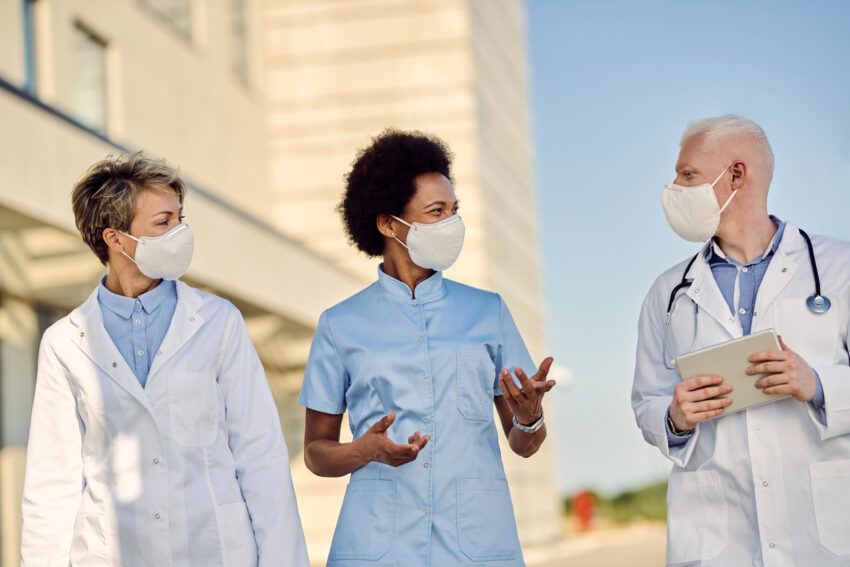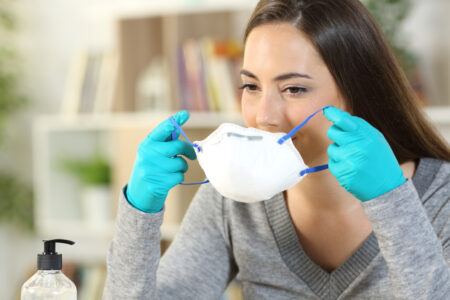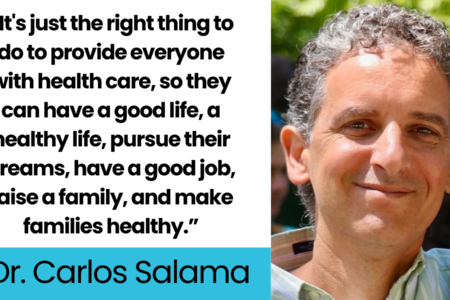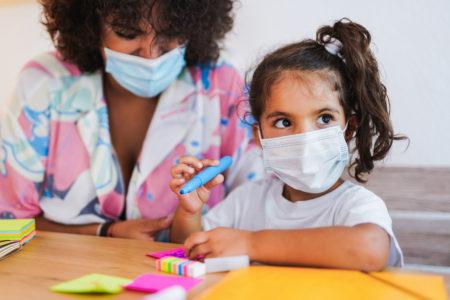
Share On Social!
A respirator keeps you from breathing in particles in the air that might hurt you, like germs, dust, and chemicals.
In healthcare, we use respirators when we think we’re going to be in a situation when we could breathe in air that’s carrying infectious particles – like viruses.
Air-Purifying Respirators
There are different types of respirators available in healthcare.
Air-purifying respirators work by using filters, or canisters or cartridges, to remove dangerous things from the air that you could breathe in.
There are many types of air-purifying respirators.
Healthcare workers often use a filtering facepiece respirator (FFR), which fit snugly against the face and cover the mouth and nose.
The most common type of FFR used in healthcare is the N95 respirator – more detail on N95s is below.
Another type of air-purifying respirator is the powered air-purifying respirator (PAPR).
“These use a battery-operated air filter and blower to get clean air to you,” said Dr. Abigail Carlson, an infectious diseases physician with the Centers for Disease Control & Prevention (CDC), as part of CDC Project Firstline’s Inside Infection Control video series. “Air is sucked in through a filtering cartridge or a canister, then blown into a mask that covers your entire face, or a hood that covers your head.”
Usually, healthcare workers use PAPRs when there is a higher risk of exposure to infectious particles in the air, or if someone has facial hair and cannot get a good seal against their face with another respirator.
Another type of respirator used in healthcare is the elastomeric half-mask respirator, which covers the nose and mouth, and the full-mask respirator, which covers the eyes, nose, and mouth.
They can be cleaned, disinfected, stored, and re-used.
When using a powered or reusable respirator, be sure to clean and disinfect the reusable parts, and make sure the filters are in place and that the respirator is properly charged.
No matter the kind of respirator used, it should fit correctly and be approved by the National Institute for Occupational Safety and Health (NIOSH) and authorized for use in healthcare by the Food and Drug Administration (FDA).
NIOSH is the part of the Centers for Disease Control and Prevention (CDC) that studies worker safety and health, providing employers and workers with the tools to create safe and healthy workplaces.
Your employer is responsible for providing you with a NIOSH-approved respirator, fit-testing, and training to make sure you use it correctly.
There may be specific times that the Occupational Safety and Health Administration (OSHA) puts in place Emergency Temporary Standards (ETS) and a Mini Respiratory Protection Program to implement respiratory protection more quickly.
Always refer to and follow your facility’s guidelines and Respiratory Protection Program.
What is an N95 Respirator?
“N95” is a term given to certain respirators tested and approved by NIOSH.
N95s keep the wearer from inhaling very small particles, including droplets that can carry virus.
They achieve this protection because of the filtering material they are made of, and because of their snug fit and seal against the wearer’s face.
Using an N95 often does two jobs at once: protecting you from viruses in the air, and protecting others from any viruses that you might breathe out.
Understanding N95 Respirators and How They Work
N95s are made of a special filtering material that NIOSH has tested and proved that it filters out at least 95% of very small particles in the air.
N95s approved for use in healthcare are also called “surgical N95s.”
A surgical N95 has features that are needed in certain situations in healthcare, such as surgery, where you may need protection against fluids, splashes, and sprays.
All N95s are made of similar filtering material, but not every N95 is the same.
NIOSH-approved N95s have two straps that go around your head, not loops that go around your ears, because loops typically aren’t able to give you the good fit and seal you need.
Before using an N95, your employer needs to provide you with a medical evaluation to make sure that you do not have any medical conditions that could get worse from using an N95.
Your employer will also perform a fit test for each model of N95 you plan to wear at work.
“You need to be fit tested for each model that you might wear at work to make sure that it fits right around your face,” Dr. Carlson explained. “If it doesn’t, you might breathe in unfiltered air through gaps around the edges of the respirator, which could make you sick.”
The N95 should fit snugly, but not super-tight.
“It’s not supposed to hurt you, but it should be a snug fit all the way around,” Dr. Carlson said. “It’s also important to put on the N95 correctly and to check, each time, the seal of your N-95 with something we call a ‘user seal check.’”
How Do I Test the Seal on My N95?
Every time you put on your N95, do a “user seal check” to make sure the air you are breathing in passes through the filtering material of the N95.
If there is a leak or bad seal, then it’s likely you’ll breathe in unfiltered air from around the sides of the N95.
“This is also why some facial hair can be a problem,” Dr. Carlson said. “If you have facial hair that sits where your respirator needs to seal to your face, it’s going to create small leaks around the edges.”
The company that makes your N95 will have instructions on how to do a user seal check for your specific type of N95.
Most of the time, the best way to check your seal is with a “positive pressure” check to make sure there are not any leaks around your face, or in the filter itself.
To do a positive pressure check:
- Put on the N95
- Put your hands lightly over the surface of the N95 and try to cover as much of the area with your hands as possible.
- Breathe out gently.
While breathing out, make sure there is a little buildup of air inside the N-95, and that air doesn’t leak around the sides.
“If there is a leak, you’re going to possibly hear it or see it,” Dr. Carlson said. “For example, you’re wearing glasses and they fog up, your face shield fogs up, or you feel the air around the edges where your hands are holding the respirator.”
Trouble-Shooting an N95 Seal Check
If the air pressure does not build up, or if air is leaking around your nose, use both hands to mold the metal nose strip to the bridge of your nose.
It’s important to use both hands and start from the top – if you use just one hand or push the sides in and “tent” or pinch the nose clip, you won’t get a complete seal, and air will escape out the top.
Think of it like clay: you want it to mold to the way your nose is formed.
You can also readjust the straps to get a better seal.
You cannot make the straps longer or shorter, but you can move them to different areas on the top and at the base of your head, to get the best possible fit.
“See where the straps work best for you but be careful not to cross them or place them directly behind the ears,” Dr. Carlson said.
If these strategies do not work and if there is still a leak, you may need to be fit-tested with a different size or model of respirator. The N95 may also be worn out and you need a new one.
What Can You Do to Promote Infection Control in Your Healthcare Setting?
Access more information about infection prevention and control in healthcare by visiting resources from CDC Project Firstline.
Project Firstline creates resources, including videos and shareable images, web buttons, posters, and print materials. They also have facilitator toolkits to help workers lead trainings even if they are not an infection control expert.
Salud America! at UT Health San Antonio is working with the National Hispanic Medical Association to bring Project Firstline infection control educational content to healthcare workers, so they are equipped with the knowledge they need to protect themselves, their facilities, and their patients (Latinos and all communities) from infectious disease threats in healthcare settings.
You can read these articles:
- What is Project Firstline?
- What’s a Virus?
- How Does Infection Control Work on COVID-19 Variants Like Omicron?
- Contact Time: What is It and How Does it Impact Infection Control?
- The Surprising Difference Between Cleaning and Disinfection
- What’s a Respiratory Droplet and Why Does It Matter?
- Why Do Cleaning and Disinfection Matter in Healthcare?
- We Need to Talk about Hand Hygiene Again
- What is the Goal of Infection Prevention and Control in Healthcare Settings?
- The Intersection of Infection Prevention and Control and Healthcare Equity
“Healthcare teams in hospitals, nursing homes, and other care settings are the front lines against the spread of infection,” said Dr. Amelie G. Ramirez, director of Salud America! at UT Health San Antonio. “CDC’s Project Firstline is bolstering those efforts by developing evidence-based tools that can be delivered in a variety of ways to make infection control learning convenient and accessible for busy healthcare staff.”
LEARN MORE ABOUT PROJECT FIRSTLINE!
Editor’s Note: This article is part of a collaboration between Salud America!, the National Hispanic Medical Association, and the CDC’s Project Firstline. To find resources training materials, and other tools to bolster knowledge and practice of infection control, visit Project Firstline and view Salud America!’s infection control content.
By The Numbers
142
Percent
Expected rise in Latino cancer cases in coming years




[…] The pandemic is another chapter in the bitter story of American racism and inequality. Black and Latinx people are being infected and are dying at much higher rates than white Americans. Many people of […]
[…] coronavirus has killed over 61,000 Latinos in America according to the CDC, accounting for over 18.2% of the total COVID deaths in the […]
[…] Whereas Hispanics make up 11% of D.C.’s inhabitants, they signify 19% of the COVID cases, and 14% of the deaths. Equally, 46% of D.C.’s residents are Black, they usually make up an alarming 75% […]
[…] and historical mistreatment. According to the U.S. Centers for Disease Control and Prevention, Latino and Black American communities are three times more likely to become infected with […]
[…] Covid pandemic has hit the Latino community particularly hard, and data from the nonprofit health equity advocacy group Salud America! shows Latinos lead in the 0-24 age […]
[…] the pandemic, Latinos took major blows, both in terms of COVID-19 cases and also from the economic recession under former President Donald Trump. Nearly half (49%) of […]
[…] the positive trend, the harm may have already been done. The pandemic has disproportionately impacted Latino communities. Reuters reported that election-related or political disinformation that […]
[…] pesar de la tendencia positiva, es posible que el daño ya esté hecho. La pandemia ha impactado desproporcionadamente Comunidades latinas. Reuters informó que la desinformación política o relacionada con las […]
[…] residentes blancos muestran una tasa mucho más baja con 10 muertes por cada 100,000 habitantes(8 9) . Los afroestadounidenses por su parte, denuncian subsistemas de salud que les segregan […]
[…] https://salud-america.org/coronavirus-case-rates-and-death-rates-for-latinos-in-the-united-states/ […]
[…] https://salud-america.org/coronavirus-case-rates-and-death-rates-for-latinos-in-the-united-states/ […]
[…] communities have the second-highest number of COVID-19 cases in the U.S. They’re also more likely to become hospitalized and die from the disease than other […]
[…] total, around 160,000 Latinos were killed by COVID-19. This accounts for 16% of the 1 million deaths in the country. The […]